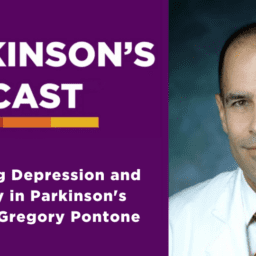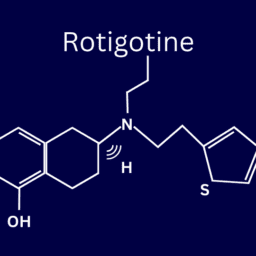Selegiline is a selective MAO-B inhibitor often used as an add-on treatment for symptoms of Parkinson’s. It is also sometimes used as the initial treatment for people who have mild symptoms.
Selegiline was developed in the 1960s and was first approved by the FDA for use in the United States in 1989. A oral disintegrating tablet (ODT) form of the drug was approved in 2006. Selegiline is also sometimes used to treat ADHD and as a transdermal patch for treatment of major depressive disorder. Dosages for these uses typically differ from the dosage prescribed for treating Parkinson’s.
MAO Inhibitor Overview
Monoamine oxidase (MAO) is a family of enzymes involved in the metabolism of monoamine chemical messengers like dopamine and other neurotransmitters. There are two types of MAO: MAO-A and MAO-B. The main differences between the types are where they are most prominent in the body and what substances they primarily metabolize. The first MAO inhibitor was used in the 1950s to treat tuberculosis and depression.
Early MAO inhibitors were non-selective, so they inhibited both MAO-A and MAO-B. This increased the risk of complications, especially from increased organ stress and interactions with other drugs. Non-selective MAO inhibitors can cause high blood pressure when a person taking them eats certain foods or takes certain medications.
MAO inhibitors approved for treatment of Parkinson’s–including selegiline–selectively inhibit MAO-B, so they are widely considered to be safer than non-selective MAO inhibitors. However, at higher doses, these drugs become less selective for MAO-B and can also inhibit MAO-A.
Since MAO inhibitors have complex risk factors, you should consult with your medical care team:
- About all medications you take before you start selegiline
- Before starting any new medication while taking selegiline
- Before stopping use of selegiline
How Selegiline Improves Parkinson’s Symptoms
By inhibiting MAO-B, selegiline decreases the breakdown of dopamine and thereby increases the amount of dopamine available in the brain. This effect increases the motor benefits of levodopa and may allow you to decrease the amount of levodopa you take each day. Decreasing your daily levodopa dose can help manage dyskinesia and help with motor fluctuations. Some research suggests additional mechanisms by which selegiline may have beneficial effect.
Uses of Selegiline in Parkinson’s
The American Academy of Neurology’s most recent treatment guidelines for early Parkinson’s indicate that clinicians may prescribe MAO-B inhibitors as the initial dopaminergic therapy for people with mild Parkinson’s symptoms. The guidelines also note:
- Levodopa typically improves symptoms more effectively than selegiline, though “initial treatment with levodopa may be more likely to induce dyskinesia.”
- Most people initially treated with selegiline add additional therapies with three years.
- Selegiline has a higher incidence of side effects than levodopa.
In light of these factors, selegiline is not the most common initial treatment. It is more commonly used in conjunction with levodopa to prolong the effect of each dose and manage ON-OFF motor fluctuations.
Selegiline’s effect on dyskinesia is more complicated. When you add selegiline to your medication regimen and it allows you to lower your daily levodopa dose, selegiline can help lessen dyskinesia. However, selegiline’s ability to extend the effect of each levodopa dose can also make dyskinesia harder to manage. Your physician may recommend that you stop taking selegiline if you experience complicated dyskinesia.
Comparing Selegiline with Other Add-on therapies
A 2021 study comparing efficacy of three common add-on therapies–dopamine agonists, MAO-B inhibitors, and COMT inhibitors–found no statistically significant difference between these types of treatments relative to quality of life. The study authors observed:
- MAO-B inhibitors were slightly more effective that COMT inhibitors as measured by two different rating scales.
- After 4.5 years, dopamine agonist use corresponded with slightly better motor symptom control.
The authors conclude that “MAO-B inhibitors produced equivalent disease control, suggesting that these agents may be underused as adjuvant therapy.” In particular, given the complex side-effect profile for many dopamine agonists, some people–especially younger people living with Parkinson’s and those who experience mood or impulse control disorders–may see better results from selegiline than from a dopamine agonist.
Is Selegiline Neuroprotective?
In the late 1980s and early 1990s, three prominent pieces of data contributed to the notion that selegiline could have a neuroprotective effect:
- Early research indicated that use of selegiline, when taken in conjunction with levodopa, corresponded with increased lifespan.
- Selegiline has been found to prevent degeneration of neurons in animals in MPTP models. MPTP is a chemical used to induce Parkinson’s-like symptoms and pathophysiology in animals.
- A 1993 study demonstrated that early use of selegiline delayed the need for levodopa to manage symptoms.
The possibility of neuroprotection was challenged in 1995 by a study that found an increased risk of death for people who took selegiline and levodopa compared to people who took only levodopa. Importantly, this study’s results were not reproduced, and a larger 1998 review found no support for increased mortality.
An article published in 2022 examines the question of whether selegiline is neuroprotective. The authors write that although selegiline showed neuroprotective potential in preclinical studies, trials in humans have not proven neuroprotection.
Selegiline’s Risks
In clinical trials for selegiline, the most common side effects included nausea, lightheadedness, and abdominal pain. Additional risks include:
Amphetamine-related side effects
Selegiline is broken down into L-amphetamine and desmethylselegiline, two substances that can cause adverse events. For example, these substances contribute to a variety of side effects, including headache, insomnia, and irritability.
Worsening Orthostatic Hypotension
Selegiline can worsen orthostatic hypotension, which is associated with increased fall risk.
Serotonin Syndrome
Selegiline slows serotonin metabolism, so when it is concurrently taken with other medications that have the same effect or increase serotonin levels, there is an elevated risk of serotonin syndrome.
This risk is generally considered to be low. For example, one study found that out of 4,568 people taking both selegiline and an antidepressant, only 11 people had symptoms that may have been consistent with serotonin syndrome. Still, the FDA’s prescribing information for selegiline advises against use of selegiline alongside tricyclic and serotonin reuptake inhibitors.
Because serotonin syndrome can be fatal, you should talk with physician about all medications you take while you take selegiline.
Blood Pressure Concerns
Selegiline can contribute to dangerous blood pressure elevation if you take it with certain sympathomimetic medications, including decongestants like ephedrine. This is because decongestants break down into substances–like norepinephrine–that raise blood pressure; thus, it is possible that selegiline would allow these substances to accumulate. For relief from nasal congestion, find safer relief from nasal congestion by using warm compresses and nasal rinsing.
Eating foods with high levels of tyramine, such as aged meats and cheeses, while taking selegiline can also contribute to elevated blood pressure. This interaction is possible because tyramine elevates blood pressure and can accumulate in the body when MAO is inhibited.
Both tyramine and sympathomimetic medications are primarily processed by MAO-A. Since selegiline selectively inhibits MAO-B, the risks of elevated blood pressure are low. However, when selegiline is taken at higher than recommended doses, it becomes less selective and inhibits both MAO-A and MAO-B. Hence, the risk of blood pressure elevation significantly increases if you take more than the recommended dose of selegiline.
Other Interactions and Risks
Visit the medications to avoid page of our medication guide for a list of some other specific medications known to have interactions with selegiline.
Further, there is insufficient safety data to recommend selegiline use during pregnancy.
Reasons To consider taking Selegiline
In addition to the general reasons to take selegiline described above, other possible benefits of taking selegiline include:
Fewer Side Effects than Dopamine Agonists
Authors of a 2009 review of research found that selegiline had fewer side effects than dopamine agonists.
Help with Depression and Anxiety
MAO inhibitors have a long history of use as a treatment for depression, and there is some evidence that–even at doses approved for use in Parkinson’s–selegiline may still affect depression. Other studies report benefit regarding anxiety.
Improvements in Gait dysfunction
In 2017, a study of 14 people with Parkinson’s found that selegiline use correlated with improvements in multiple measures of gait disturbance.
Decreases in Daytime sleepiness
A small study published in 2021 found that selegiline use correlated with a decrease in daytime sleepiness for 41 of 45 people. Two participants in the study remained stable and two people in the study had an increase in daytime sleepiness.
Lower Cost and Better Coverage
Selegiline is usually less expensive than the other comparable MAO-B inhibitor: rasagiline. While there is limited data comparing the efficacy of rasagiline and selegiline, existing data suggests that the effect on symptom management is similar. Moreover, some prescription plans do not cover rasagiline or only cover it after selegiline treatment is attempted and proved ineffective.
The Possibility of Neuroprotection
Research has failed to prove that selegiline has a neuroprotective effect for people with Parkinson’s. However, researchers have articulated many ways in which MAO inhibition may be neuroprotective.
Especially if you experience very mild early symptoms or symptoms incompletely managed by just levodopa, that selegiline may have a slight ability to slow progression of Parkinson’s could be reason for you and your care team to consider including it as a part of your treatment plan.
Further Reading
Prescribing Information: Capsule Formulation of Selegiline
Prescribing Information: Dissolving Formulation of Seligiline
Life Expectancy and Selegiline
NIH Library of Medicine Article on Selegiline
WANT MORE PRACTICAL ARTICLES LIKE THIS?
You can learn much more about living well with Parkinson’s today through our Every Victory Counts® suite of resources. Each manual is packed with up-to-date information about everything Parkinson’s. Click the link below to reserve your manual(s).

















